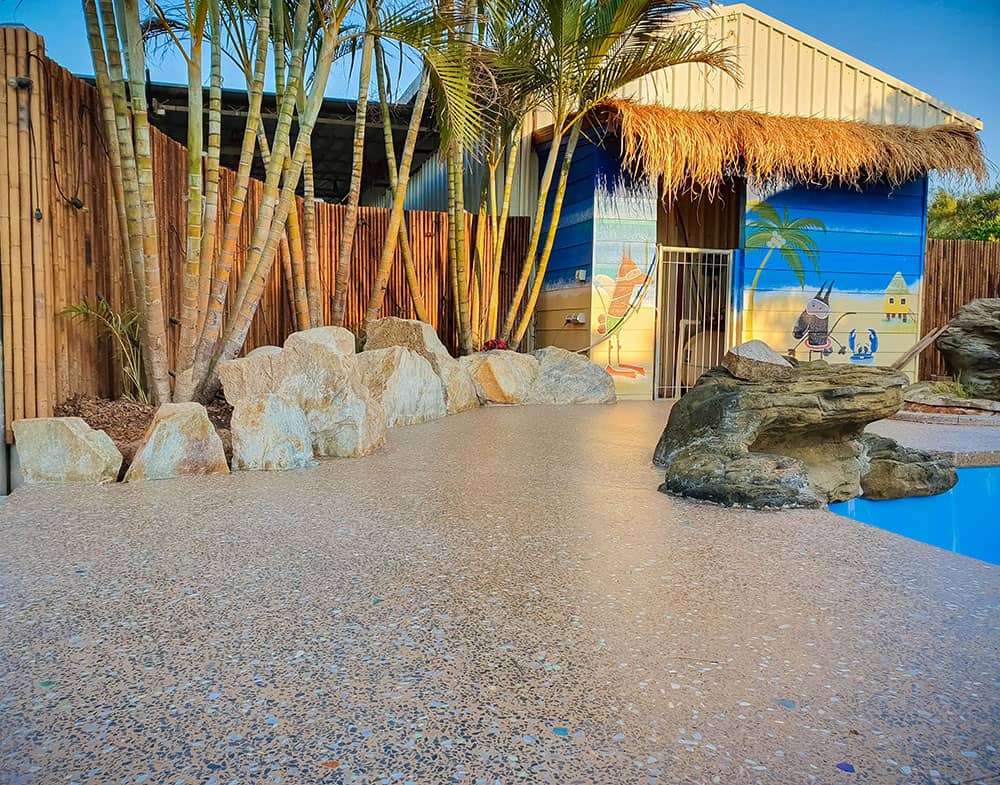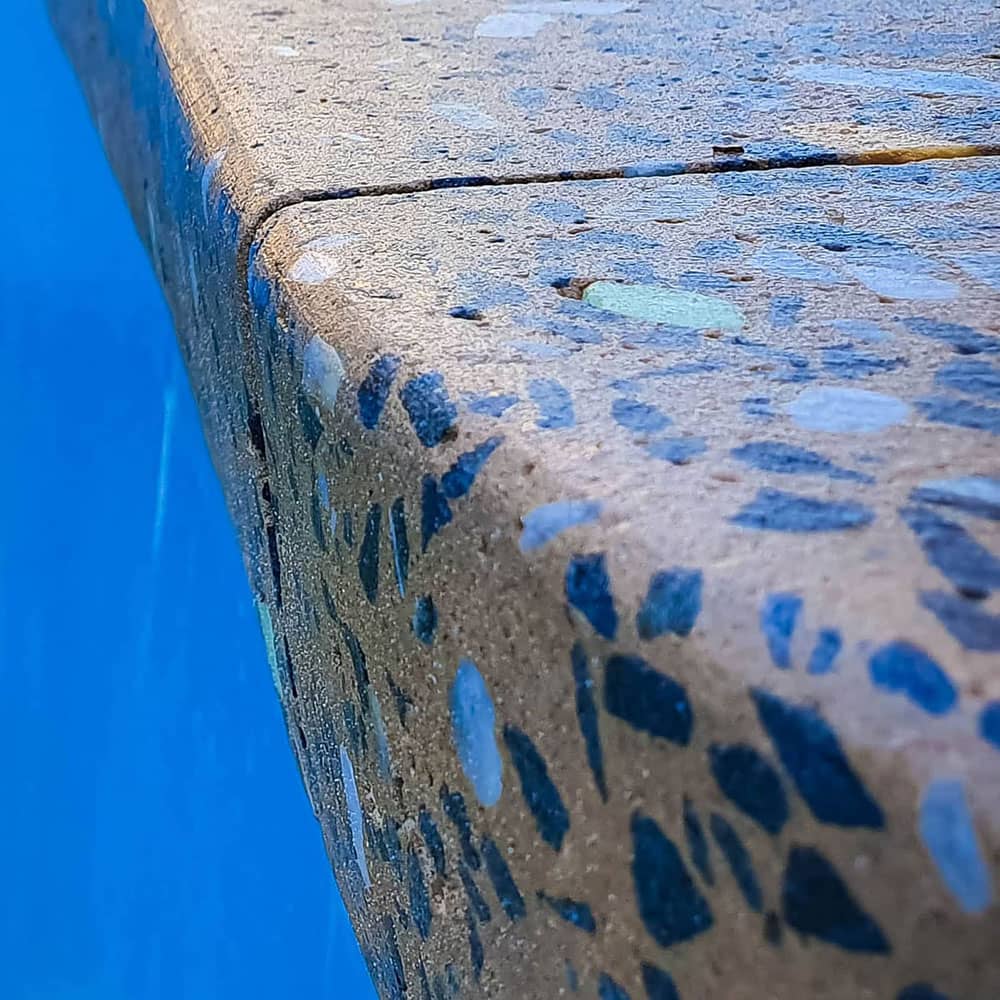Concrete Pool Edging: The Crowning Glory of Your Pool
- August 1, 2021
- Written By Brad Russell
- Benefits of Decorative Concrete
Swimming pools are an excellent addition to your backyard. But the installation process is more complex than most people think. It takes time and a lot of planning. There are many decisions to make, not just the size, depth, shape, but also the finish. The pool’s finish is a critical component that can affect both aesthetics and practicality. And while you’re thinking about the best finish for your pool, you will encounter the term “pool edging.”

What is Pool Edging?
Some contractors refer to pool edging as pool coping. It simply refers to the material used for the edges around the pool shell wall. When you’re in the pool and hang on to its top edge, you’re touching or grabbing on to the coping.
Think of it as the crowning glory of your swimming pool because of how it separates the pool shell from the entire surrounding area. At the same time, it helps protect the structure of the pool. It’s the exact thing that stops water from getting at the rear of the pool shell.
Correct pool edge installation is essential; otherwise, water splashing out of the pool will flow back to the pool instead of going down the drains. Pool edging is installed on the bond beam, which essentially covers the edges of the concrete. The bond beam is actually the horizontal structure found at the top perimeter of the swimming pool. It’s often made of concrete and steel to add strength to the pool wall.
There is hidden steel jutting from the pool walls, but it’s concealed by the coping so that the pool looks better. Apart from keeping water from splashing behind the shell, it also complements its finish and tile.
Is Pool Edging Necessary?
If you have an in-ground swimming pool made of concrete, then pool edging is a must. The pool will need a cap for its edges. Coping is indeed necessary because it’s what helps keep water flowing away from the pool once it is splashed out. That’s why pool edging should be installed by a professional who understands the importance of having the edging tilted slightly away from the structure.
But pool coping is not only used for the reasons mentioned. Many homeowners and designers actually opt for pool edging or coping because it provides them with a chance to use their preferred decorative accent. Surely, you do not want your pool to be boring. Pool edging can help enhance the look of the whole structure. The process varies widely, depending on the surrounding, material used, and style.
For example, the pool edge can first be cast in corners, curved, or straight sections. Stones will be used, and most of the time, they are made of a combination of white and grey porous concrete. Coping stones are matched with other pool features, such as wood or concrete decking, which extends over the edge of the pool ever so slightly.
In addition to aesthetics, pool edging offers a non-skid surface. Every pool owner knows that a slippery pool surround is a big no-no. When properly installed, pool edging allows swimmers to walk comfortably and safely before getting into the water.
Pool Edging Materials and Styles
Coping is great for a concrete swimming pool. Different materials can be used for the pool edge, such as natural stone and precast concrete. Here are the differences:
-
Precast concrete offers different textures, colours, and patterns without the high cost. It’s typically more affordable than natural stone and even poured concrete. This material is also easier to install and provides uniform colour and thickness, which you cannot get from natural stone.
-
Natural stone, on the other hand, is also called brick coping. It’s warm and sturdy with a good texture. The material used ranges from limestone, fieldstone, and granite. It’s harder to work with, mainly because it is more demanding and requires specific and consistent thickness.
Pavers have also come up with other styles for pool edging, such as bullnose, which gives a seamless look for the pool and deck.
Single bullnose has become quite popular, but there are other stylish options to choose from, such as:
- Bullnose involving round edging for a smoother look and style, letting swimmers climb in and out easily
- Square Edge, which, as the name suggests, has a square edge, giving the coping a simple and elegant look
- Rebated Square Edge, which is the preferred style in many modern homes because it hangs or floats over the surface
- Exposed Aggregate coping for a textured surface and added grip
During construction, the pool edging material suitable for your pool will be installed on the bond beam. If it is a swimming pool renovation, the selection of the pool edging style will mostly depend on the existing shape and paving. It’s important to consider how the edging type will contribute to the overall look of the pool. At the same time, the material used should easily withstand salt for saltwater pools, as well as other chemicals. Finally, pool edging should provide a non-slip surface to ensure all swimmers are safe when walking around the pool area.
Seamless pool edging can enhance the look of your pool and your whole backyard. And if for whatever reason, you do not like the idea of installing a pool edge, you have other options. The most common alternative is to have the wood or pool decking enlarged, allowing it to slightly extend over the edge of the pool. It will then cover all the way around the pool perimeter. It does offer a similar look with a seamless border, but it does not provide the same benefits as having a pool edge.
At Decorative Concrete WA, we can assist you with all your pool edging needs, give us a call today!

